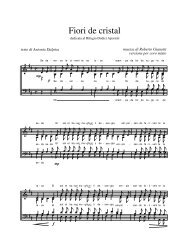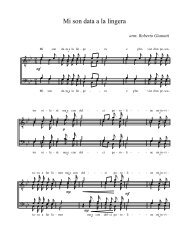Latin texts and notes - Gianotti Roberto
Latin texts and notes - Gianotti Roberto
Latin texts and notes - Gianotti Roberto
Create successful ePaper yourself
Turn your PDF publications into a flip-book with our unique Google optimized e-Paper software.
Metronome times <strong>and</strong> tones<br />
Anyone who listens to the symphony K 550 by Mozart in the recording conducted by Bruno Walter (1959)<br />
<strong>and</strong> in the one conducted by Frans Brüggen (1985) will be struck by the remarkable difference in metronome<br />
times chosen by the two conductors.<br />
Every artistic expression reflects the historical <strong>and</strong> cultural circumstances of its epoch, <strong>and</strong> every historical epoch<br />
reflects a mentality, taste, lifestyle or cultural movement of its own: a collection of factors which determine the<br />
aesthetics of musical interpretation, influenced in turn by the stylistic knowledge thus far acquired.<br />
The period between the 1950s <strong>and</strong> 1990s brought that important movement defined early music which transformed<br />
the manner of performing music of the past. Though we do not intend to dwell on an analysis of this<br />
phenomenon, it is clear that new knowledge led to a different reading of the repertoire which until then had<br />
been performed on modern instruments, proposing very different tempi for performance on original instruments,<br />
tempi that are generally more agile than the ideas of sound <strong>and</strong> of typical instrumental techniques of the first<br />
half of the twentieth century. In eighteenth-century repertoire variations of tempo can be as marked as in the<br />
examples given above, but in the preceding repertoire this happens to a far lesser degree, as the Tempo is based<br />
on a system which leaves much less room for the performer’s discretion.<br />
By the end of the fifteenth century a metronomic pulse (Tactus) was already set on a pulse beat which has had<br />
no significant variation in human physiology. This pulse beat was the basis for a system of mensurations <strong>and</strong><br />
of the proportions (prolations) whose signs are to be seen – in Monteverdi’s age – as very precise scansion<br />
values. These signs, though no longer <strong>and</strong> not merely founded on the absolute arithmetical proportions of the<br />
previous age are subject to a certain graduality of time scansions according to the “mensurations” used by<br />
composers to match the feeling, expression or solemnity of their works. Girolamo Frescobaldi writes 1 : “… in<br />
the triples or sesquialtera, if these be greater then let them be conducted slowly (adagio), if they be lesser then somewhat<br />
more briskly (allegro), if they be in three crotchets, more briskly, if they be in six fourths let their tempo be given<br />
so as to have the beat move merrily.”<br />
From about the middle of the seventeenth century, the tempi came increasingly to be identified with the names<br />
of dances, now in the more flexible indications of Allegro, Andante, Adagio etc; these are less subject to prolation<br />
signs <strong>and</strong> leave the performer a certain elasticity in the choice of Tempo.<br />
In the better-known repertoire we can thus easily identify incongruence when an Andante is performed as a<br />
Presto, or an Allegro as an Adagio. In Monteverdi’s music, however, this is less obvious since audiences <strong>and</strong><br />
performers alike are still influenced by recordings which, through common usage that has now become tradition,<br />
do not respect the proportions indicated by the composer, on account of our ingenuousness, convenience or<br />
errors in transcription.<br />
The result, though it may be far from the composer’s idea, often sounds to today’s listener no less plausible or<br />
charming <strong>and</strong> attractive in evoking popular <strong>and</strong> ethnic suggestions, closer to our modern taste but which have<br />
little to do with the composition. This is found most clearly in triple times but is also encountered in some<br />
binary rhythms, where changes of tempo are added that are not indicated by the author, which radically alter<br />
the original text. This is why the proportions of the tempi may sound too slow to our ears, in contrast with the<br />
mentality of our time, which is distinguished by a generic sense of frenzy that can easily lead us to seek a<br />
brilliant dance rhythm in every ternary time.<br />
This observation is necessary in the presentation of this recording since the Vespers for the Blessed Virgin, though<br />
belonging to the more ancient repertoire, is a frequently performed work: adhering to the proportions that Monteverdi<br />
indicates meticulously (meticulousness witnessed by Giovanni Battista Doni 2 ) leads to a performance<br />
that is surprisingly different from what is traditionally proposed. It might even seem to the listener’s ear to be<br />
a free, personal re-interpretation of the original text <strong>and</strong> could provoke the same perplexity as we feel with the<br />
restoration of masterpieces of painting of the past when the removal of century-old incrustations that altered<br />
the original colours reveals a work of art quite different from what had thus far been interpreted <strong>and</strong> explained<br />
on the basis of distorted aesthetics far removed from the artist’s expressive intent: many aesthetic <strong>and</strong> philological<br />
theories are suddenly found to be based on a fundamental misunderst<strong>and</strong>ing. Throughout the history of<br />
music performance the metronome tempo of the more recent repertoire has been subject to variations, some<br />
very evident, but in the more ancient repertoire the performer is obliged to observe indications that are not<br />
variable at all <strong>and</strong> which leave far less flexibility in the choice of performance tempo given the precise signs of<br />
10














